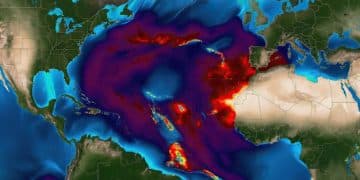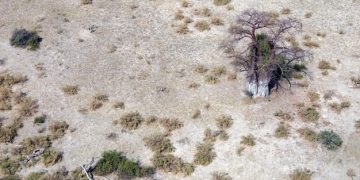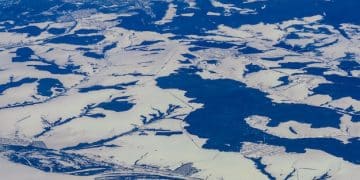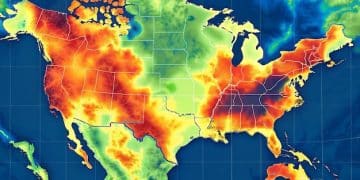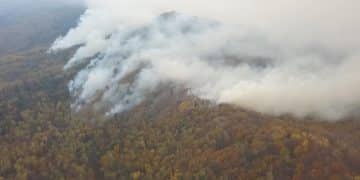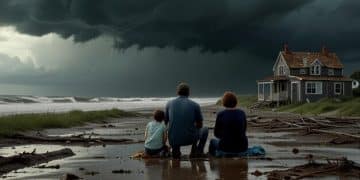Wildfire Frequency in US: Unraveling the Science
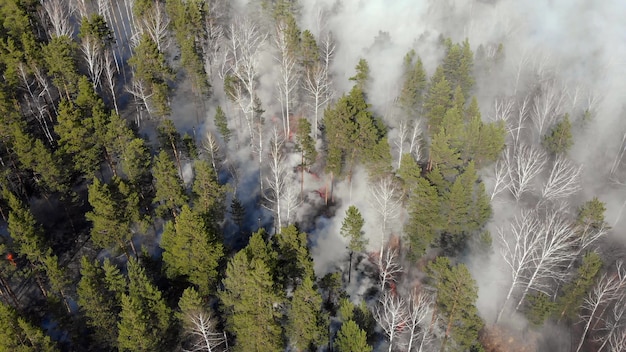
The escalating frequency and intensity of wildfires across the United States are directly linked to profound scientific shifts, including a warming climate, altered precipitation patterns, and human-induced land-use changes, as data robustly indicates.
In recent decades, wildfires have become an increasingly dominant and destructive force across the United States, transforming landscapes, threatening communities, and impacting air quality. The perceived uptick in these events begs a crucial question: What is driving this apparent surge? Delving into The Science Behind Increased Wildfire Frequency in the US: What the Data Shows reveals a complex interplay of environmental factors, meteorological phenomena, and human activities. This article aims to explore the empirical evidence and scientific consensus behind this pressing issue, examining the data that illuminates the core drivers of this critical environmental challenge.
climate change and its role in wildfire escalation
The scientific community largely agrees that climate change is a primary accelerant in the increasing frequency and severity of wildfires, particularly in the Western United States. A warmer world translates into longer, drier fire seasons and more combustible landscapes.
Rising global temperatures, a hallmark of climate change, have a direct and measurable impact on the conditions ripe for wildfires. The data from various meteorological agencies consistently shows an upward trend in average temperatures across the US, particularly pronounced in areas prone to wildfires. This sustained warmth leads to earlier snowmelt, reduced soil moisture, and an overall drying of vegetation.
how rising temperatures fuel fires
Higher temperatures directly increase the evaporation rate from soils and vegetation, creating more arid conditions. This process, known as aridity, is a critical precursor to increased fire activity. The desiccation of fine fuels like grasses and small shrubs means they ignite more easily and spread fire more rapidly.
- Earlier Snowmelt: Snowpacks are melting earlier in the spring, extending the dry season length by several weeks in some regions.
- Increased Evaporation: Warmer temperatures lead to greater evaporation from reservoirs, lakes, and soil, reducing water availability for ecosystems.
- Vegetation Stress: Prolonged heat and drought stress vegetation, making it more susceptible to igniting and burning intensely.
Furthermore, climate change isn’t just about rising averages; it’s also about the increased intensity and frequency of extreme heat events. Heatwaves themselves can prime an area for fires, not only by drying out fuels but also by stressing trees, making them more vulnerable to insect infestations, which in turn can kill trees and create more standing dead fuel.
changes in precipitation patterns
While some regions might experience increased precipitation, many wildfire-prone areas are seeing a decrease in overall rainfall or changes in its timing and intensity. Rather than gentle, widespread rains that can suppress fire risk, precipitation often comes in fewer, more intense downpours, leading to run-off rather than deep soil saturation.
This irregular precipitation contributes to prolonged periods of drought, especially in the Western and Southwestern US. Drought conditions are directly linked to higher fire risk, as they lead to extremely dry fuels. Scientists use indices like the Palmer Drought Severity Index (PDSI) to track these conditions, and the data clearly illustrates an expansion and intensification of drought across critical fire regions.
The nexus between a warming climate, altered precipitation, and wildfire frequency is not merely theoretical; it is demonstrably supported by decades of observational data. The changes observed are consistent with climate model predictions, offering a robust scientific basis for understanding this alarming trend.
fuel accumulation and forest management practices
Beyond climate change, the way forests have been managed, particularly over the past century, has significantly contributed to the build-up of combustible fuels, making wildfires hotter and harder to control. Historical fire suppression policies, coupled with changing logging practices, have altered the natural fire regimes.
For many decades, the prevailing policy across the US was aggressive fire suppression. The goal was to extinguish every fire as quickly as possible, often under the misguided belief that all fires were inherently bad. While this approach protected communities and timber resources in the short term, it inadvertently had severe long-term consequences for forest health and fire risk.
the legacy of fire suppression
Historically, many forest ecosystems, particularly in the Western US, evolved with frequent, low-intensity fires. These natural fires would clear out undergrowth, dead trees, and other fine fuels, keeping the forest floor relatively clean. This created a mosaic of clearings and less dense patches, preventing the buildup of continuous fuel ladders that allow ground fires to climb into the canopy.
With aggressive suppression, these natural clearing mechanisms were removed. Decades of unburned vegetation accumulated on the forest floor, creating an unprecedented fuel load. Instead of frequent, small fires, the landscape became primed for infrequent, catastrophic wildfires that burn with extreme intensity, often leading to crown fires that destroy entire stands of trees and are nearly impossible to control.
- Increased Fuel Loads: Accumulation of dead trees, branches, and underbrush creates a continuous fuel bed.
- Higher Tree Densities: Forests became unnaturally dense, increasing competition for water and making trees more susceptible to disease and drought.
- Fuel Ladders: Small-diameter trees and shrubs grow tall enough to carry fire from the ground into the main canopy.
The shift from low-intensity ground fires to high-intensity crown fires is a critical aspect of understanding the increased destructiveness. These crown fires release immense amounts of energy, create their own weather systems, and are notoriously difficult for firefighters to combat, often resulting in widespread, irreversible ecological damage.
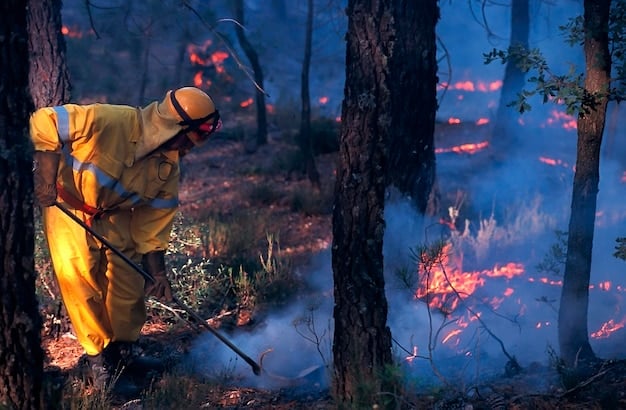
changing logging and land use practices
Beyond fire suppression, changes in logging practices have also played a role. Historically, selective logging might have thinned forests, but modern practices often focused on clear-cutting or removing only the largest, most fire-resistant trees, leaving behind smaller, more flammable species and logging debris.
Additionally, the continued expansion of human settlements into the wildland-urban interface (WUI) brings more homes and infrastructure into direct contact with fire-prone landscapes. This encroachment not only increases the ignition risk but also adds complexity to fire management, as fire suppression efforts must prioritize protecting human lives and property, sometimes at the expense of allowing natural fire processes to occur elsewhere.
The combination of historical fire suppression, accumulation of fuels, and changing human land-use patterns has created a dangerous feedback loop, making wildfires more frequent, larger, and more destructive than ever before. Addressing this requires a paradigm shift in forest management, embracing practices that mimic natural fire regimes and reduce fuel loads through thinning, prescribed burning, and community preparedness.
the impact of human activity and ignitions
While environmental factors like climate and fuel accumulation set the stage for wildfires, human activities remain the predominant source of ignitions, particularly in the United States. Data consistently shows that a vast majority of wildfires are started by people, directly or indirectly.
The statistical evidence is stark: over 85% of wildfires in the US are caused by humans. These ignitions can range from accidental sparks from equipment, unattended campfires, discarded cigarettes, and arson, to power line failures and debris burning gone awry. Even fireworks and target shooting contribute significantly to the ignition count.
common human-caused ignitions
Understanding the specific causes helps in developing targeted prevention strategies. For instance, accidental ignitions from equipment often surge during agricultural seasons or specific industrial activities. Campfire-related ignitions tend to peak during recreational periods, while debris burning fires are more common in rural and suburban areas.
- peralatan dan mesin: Sparks from chainsaws, farming equipment, or vehicles operating in dry grass.
- Tidak dijaga Campfires: Fires left unattended or not properly extinguished in forests and parks.
- Kegagalan Jalur Daya: Downed power lines or sparks from malfunctioning electrical infrastructure.
- Pembakaran Rongsokan: Uncontrolled or improperly managed burning of yard waste and debris.
The proliferation of human presence in and around wildland areas, known as the Wildland-Urban Interface (WUI), exacerbates this issue. As more homes and communities are built in fire-prone environments, the probability of human-caused ignitions naturally increases. The WUI is where human development meets undeveloped wildland, creating a high-risk zone where fires can easily transition between natural fuels and man-made structures.
arson and negligence
Beyond accidental ignitions, intentional acts of arson contribute to wildfire frequency, though they are often harder to categorize and prevent. Negligence, on the other hand, accounts for a significant portion of preventable human-caused fires. This includes failing to secure chains on trailers, which can dragging and cause sparks, or not properly extinguishing campfires.
The challenge lies in balancing public access and recreational opportunities with the imperative of fire prevention. Educational campaigns play a vital role in raising awareness about fire safety practices, especially during fire season. However, even with widespread public awareness, the sheer volume of human activity across vast and diverse landscapes makes complete prevention an ongoing challenge.
Ultimately, while climate change creates the conditions for more intense fires, human activity acts as the spark. Reducing wildfire frequency necessitates a multi-faceted approach that not only addresses global climate trends and forest management but also emphasizes individual responsibility and community-level prevention efforts to mitigate human-caused ignitions.
atmospheric conditions and extreme weather events
Beyond long-term climate trends, specific atmospheric conditions and extreme weather events play an immediate and critical role in driving wildfire intensity and spread. These short-term phenomena can turn a small ignition into a catastrophic blaze and are increasingly influenced by a changing climate.
The concept of “fire weather” describes meteorological conditions that are particularly conducive to the ignition, spread, and intensity of wildfires. These typically include high temperatures, low humidity, and strong winds. The combination of these three factors can rapidly transform a landscape from manageable to highly volatile.
the dangerous trio: heat, dryness, and wind
Heat: As previously discussed, high temperatures bake moisture out of vegetation, turning living plants and dead organic matter into tinder. Record-breaking heatwaves are becoming more frequent and intense, directly correlating with periods of heightened fire risk.
Dryness (Low Humidity): Low relative humidity means there is very little moisture in the air to be absorbed by fuels. This causes fuels to dry out even further and faster, making them more receptive to ignition and allowing fires to spread more quickly across the landscape.
Wind: Wind is arguably the most dangerous component of fire weather. It provides a constant supply of oxygen to the fire, increasing its intensity. More critically, wind pushes flames forward, carrying embers significant distances, leading to rapid fire spread and the creation of new spot fires ahead of the main front. Extreme wind events, sometimes associated with specific weather patterns or topographical features, can drive fires through seemingly impassable barriers.
- Red Flag Warnings: Issued by the National Weather Service when critical fire weather conditions are occurring or imminent.
- Diurnal Wind Patterns: Daily wind shifts, often exacerbated by terrain, influencing fire behavior.
- Dry Lightning: Thunderstorms that produce lightning but little to no rain, providing a natural ignition source in already dry conditions.
The role of wind is particularly devastating. When winds are strong and erratic, fire behavior can become extremely unpredictable, making it hazardous for firefighters and difficult to anticipate spread patterns, leading to greater risk to communities and infrastructure.
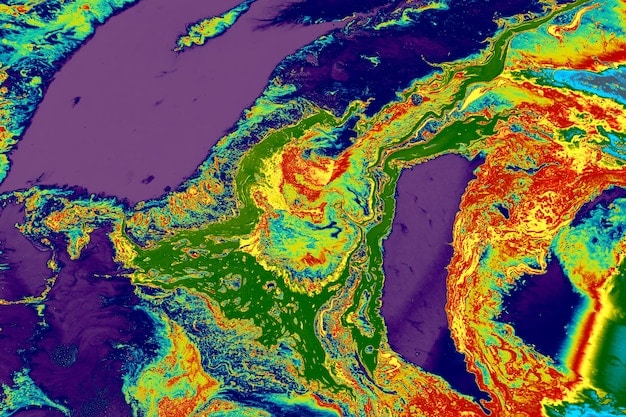
increasing frequency of extreme weather
Scientific research increasingly points to a connection between climate change and an uptick in certain extreme weather phenomena that contribute to wildfires. While individual events cannot be solely attributed to climate change, the overall pattern suggests a higher likelihood of conditions favorable for wildfires.
For example, the frequency of dry lightning, which is a significant source of natural ignitions, particularly in the Western US, is projected to increase with a warming climate. Similarly, certain atmospheric pressure systems can lead to prolonged periods of drought and heat, setting the stage for massive fire events. The data indicates that extreme fire weather days are becoming more common and occurring over larger areas, contributing directly to the observed increase in megafires.
The intricate dance between atmospheric conditions and wildland fuels is a critical aspect of wildfire science. Understanding these dynamics is essential for improving fire prediction models, enhancing early warning systems, and developing more effective strategies for rapid response and mitigation during peak fire seasons.
wildlife and ecosystem impacts of frequent fires
The increasing frequency and intensity of wildfires have profound and often devastating impacts on wildlife populations and the broader ecosystems they inhabit. While fire is a natural process in many ecosystems, the current scale and severity are exceeding the adaptive capacities of many species and habitats.
Wildfires directly threaten wildlife through immediate mortality during the blaze. Animals that are slow-moving, or those unable to escape the path of a fast-moving crown fire, often perish. This includes small mammals, reptiles, amphibians, and countless invertebrates. Birds can sometimes escape, but their nests and young are frequently destroyed.
habitat destruction and ecosystem disruption
However, the impacts extend far beyond immediate mortality. Post-fire landscapes often suffer from significant habitat loss and fragmentation. The destruction of forests, shrublands, and grasslands removes essential food sources, shelter, and breeding grounds for numerous species. This compels survivors to migrate, often into already stressed areas, increasing competition for resources and potentially leading to further population declines.
- Loss of Food Sources: Fires incinerate vegetation, removing the primary food source for herbivores and subsequently impacting their predators.
- Altered Water Cycles: Burnt soils can become hydrophobic, leading to increased runoff, erosion, and altered stream flows, impacting aquatic life.
- Invasive Species Introduction: Disturbed fire-burnt areas are often colonized by invasive plant species, outcompeting native vegetation.
The long-term effects on ecosystems can be even more insidious. Soil health is severely compromised as intense heat sterilizes the ground, burning off organic matter and beneficial microorganisms. This can lead to increased erosion, especially with subsequent rainfall, and can hinder the natural regeneration of vegetation. Ash runoff into rivers and lakes can negatively impact water quality, harming aquatic life and entire freshwater ecosystems.
species adaptation vs. extreme fires
While some ecosystems and species (like the Lodgepole Pine, relying on fire for cone release) are adapted to periodic fire disturbances, the current extreme fire regimes pose an unprecedented challenge. These “megafires” burn so hot and large that they can push ecosystems beyond their natural recovery thresholds. Instead of regenerating with native species, fire-adapted landscapes might shift to entirely different vegetation types, or become permanently degraded. For instance, some forests might convert to shrublands, altering the entire ecological character of the region.
Furthermore, climate change can disrupt the delicate balance between species’ life cycles and fire regimes. If fires occur too frequently, native plants may not have enough time to mature and produce seeds, preventing successful regeneration. This can lead to localized extinctions or the slow decline of vulnerable populations.
The observable impacts on wildlife, from visible burns on animals to the long-term changes in forest composition, underscore the profound ecological disruption caused by the increased frequency and intensity of wildfires. Protecting biodiversity and ensuring ecosystem resilience requires a holistic approach to fire management that considers these complex ecological interactions.
economic and societal consequences of increased wildfires
The escalating frequency and intensity of wildfires inflict a severe and multifaceted toll on the economy and society, extending far beyond the immediate damage to property. These consequences affect entire regions, industries, and the quality of life for millions of Americans.
One of the most visible economic impacts is the direct destruction of homes, businesses, and critical infrastructure. The cost of replacing destroyed property, along with the disruption to local economies reliant on tourism or forestry, runs into billions of dollars annually. Beyond structural damage, agricultural lands and timber resources are frequently incinerated, leading to losses for farmers and the timber industry.
financial burdens and health impacts
The financial burden on public resources is immense. Fire suppression efforts require vast budgets for equipment, personnel, and emergency services. These costs have soared in recent years, diverting funds from other public services. Additionally, there are significant post-fire costs associated with rehabilitation, erosion control, and rebuilding infrastructure, which can take years to complete.
- Increased Insurance Premiums: Homeowners in fire-prone areas face skyrocketing insurance costs, or even outright denial of coverage.
- Healthcare Costs: A surge in respiratory illnesses and other health issues due to prolonged smoke exposure.
- Tourism Decline: Fire-affected areas experience a significant drop in tourism and recreational activities, hitting local businesses hard.
Beyond the direct financial costs, wildfires have significant public health implications. Smoke plumes can travel for hundreds or even thousands of miles, degrading air quality far from the fire front. Fine particulate matter (PM2.5) in wildfire smoke can penetrate deep into the lungs, exacerbating respiratory conditions like asthma and chronic obstructive pulmonary disease (COPD), and contributing to heart attacks and strokes. Public health agencies issue air quality alerts, prompting school closures and advising vulnerable populations to stay indoors, disrupting daily life and economic activity.
social disruption and mental health challenges
The societal impacts are equally profound. Mass evacuations displace thousands, creating humanitarian challenges and immense stress for affected communities. The loss of homes, livelihoods, and cherished memories can lead to long-term psychological trauma, including anxiety, depression, and post-traumatic stress disorder (PTSD), affecting both survivors and first responders.
The increased fire frequency also creates a sense of instability and fear, particularly in communities living in the Wildland-Urban Interface. This ongoing threat can erode social cohesion and trust, as residents grapple with the constant risk and the difficult decisions surrounding rebuilding or relocating. The stress on emergency services, from firefighters to medical personnel, is also a significant concern, leading to burnout and fatigue.
In essence, the science behind increased wildfire frequency in the US points to a future where these events are not just environmental disasters but also significant economic and social disruptors. Addressing this challenge requires not only mitigation and adaptation strategies but also robust policies that acknowledge and plan for the pervasive and devastating consequences across all sectors of society.
mitigation strategies and future outlook
As the science behind increased wildfire frequency becomes clearer, so too does the urgency to implement comprehensive mitigation strategies. Addressing this complex problem requires a multi-faceted approach that spans forest management, community preparedness, and climate action.
One primary area of focus is proactive forest management. This involves shifting away from decades of aggressive suppression and embracing practices that mimic natural fire regimes. Techniques like prescribed burning and mechanical thinning are crucial for reducing fuel loads in overcrowded and unnaturally dense forests. Prescribed burns, conducted under carefully controlled conditions, can clear out undergrowth and prevent the accumulation of fuels, making subsequent fires less severe and more manageable.
adaptive forest management practices
Mechanical thinning involves removing smaller trees and underbrush to reduce competition for resources and create greater spacing between trees. This makes it harder for ground fires to climb into the canopy and become destructive crown fires. These practices are often combined to create “defensible space” around communities and critical infrastructure.
- Fuel Breaks: Creating wide areas with reduced vegetation to slow or stop fire spread.
- Strategic Thinning: Selectively removing trees to reduce forest density and flammability.
- Community Education: Empowering residents to create defensible space around their homes and follow fire-safe practices.
Another critical strategy is enhancing community resilience, particularly in the Wildland-Urban Interface (WUI). This includes encouraging homeowners to harden their homes against embers (e.g., using fire-resistant roofing and siding, maintaining clear gutters), creating defensible space by removing flammable vegetation within a certain radius of homes, and developing robust evacuation plans. Building codes and planning policies can also play a vital role in preventing new development in high-risk areas or mandating fire-resistant construction materials.
technological advancements and policy shifts
Technological advancements are also contributing to better wildfire management. Improved satellite monitoring and drone technology offer real-time data on fire behavior and spread, aiding in more efficient resource deployment. Advanced modeling can predict fire paths and intensity, allowing for better preparedness and targeted interventions. Early detection systems, including networks of sensors and cameras, can significantly reduce response times.
Ultimately, a significant part of the future outlook hinges on large-scale climate action. While local and regional mitigation efforts are crucial, addressing the root causes of climate change—reducing greenhouse gas emissions—is essential for mitigating the long-term trends of hotter, drier conditions that predispose landscapes to more frequent and intense fires. This requires global cooperation and a commitment to transitioning to cleaner energy sources.
The future of wildfire management in the US will likely involve a combination of these strategies: proactive forest health treatments, community preparedness, technological innovation, and a fundamental shift towards addressing climate change. While the challenges are immense, the scientific understanding and available tools offer a path forward to living more sustainably with fire in a changing world.
| Key Factor | Brief Description |
|---|---|
| ☀️ Climate Change | Rising temperatures and altered precipitation create drier conditions and longer fire seasons, increasing ignitibility. |
| 🌳 Fuel Accumulation | Historical fire suppression and changes in forest management have led to excessive build-up of combustible vegetation. |
| 🚶 Human Activity | Over 85% of wildfires are human-caused, stemming from accidental sparks, negligence, or arson, especially in the wildland-urban interface. |
| 💨 Extreme Weather | Conditions like high winds, low humidity, and heatwaves intensify fire spread and increase the likelihood of rapid escalation. |
frequently asked questions about wildfires
▼
No, not all wildfires are inherently bad. Many ecosystems, particularly in the Western US, have evolved with and are dependent on natural fire cycles for regeneration. Low-intensity fires can clear undergrowth, enrich soil with nutrients, and promote the growth of fire-adapted species. However, the increased frequency and intensity of modern wildfires, often leading to destructive megafires, can be detrimental to ecosystems and human communities.
▼
Living in the Wildland-Urban Interface (WUI)—where human development meets undeveloped wildlands—significantly increases wildfire risk. This proximity not only raises the probability of human-caused ignitions but also complicates fire suppression efforts, as firefighters must prioritize protecting lives and structures. Homes in the WUI are directly exposed to fire hazards, and their presence makes it critical for residents to practice “defensible space” landscaping and use fire-resistant building materials.
▼
Defensible space is the area around a building where combustible vegetation and materials have been cleared or reduced to slow the spread of wildfire. It’s crucial because it gives firefighters a safer area to work in and significantly increases the chances of a home surviving a wildfire. Creating defensible space involves removing dead plants, keeping lawns mowed, clearing gutters, and strategically planting less flammable vegetation within a specific zone around a structure.
▼
Yes, prescribed burns are a key tool in mitigating wildfire risk and can indirectly reduce the frequency of large, destructive fires. By intentionally setting low-intensity fires under carefully controlled conditions, land managers can significantly reduce accumulated fuel loads (dead leaves, branches, undergrowth). This prevents these fuels from contributing to catastrophic blazes. Regular prescribed burns help restore natural fire regimes and make forests healthier and more resilient to uncontrolled wildfires, ultimately reducing their overall frequency and intensity.
▼
Power lines can play a significant role in starting wildfires, especially during periods of high winds or in areas with dense vegetation. Falling power lines, sparks from damaged equipment, or even contact with vegetation can generate ignitions. Utility companies are increasingly investing in grid hardening, undergrounding lines, and vegetation management programs to minimize this risk. However, power line-caused wildfires remain a concern, particularly in high-risk zones, and represent a notable percentage of human-caused ignitions.
conclusion
The scientific data unequivocally paints a picture of a profound shift in wildfire dynamics across the United States. While natural cycles and lightning strikes have always been a part of forest ecosystems, the escalating frequency, intensity, and destructive power of recent wildfires are strongly linked to an intricate and reinforcing combination of factors. Climate change, with its undeniable signature of rising temperatures and altered precipitation, has extended fire seasons and desiccated landscapes, creating the perfect tinderbox. This environmental predisposition is further exacerbated by over a century of fire suppression policies that have led to unprecedented fuel accumulation, transforming once-resilient forests into highly flammable areas. Moreover, human activity remains the crucial igniter for the vast majority of these fires, with expanding populations in the wildland-urban interface increasing both exposure and vulnerability. Addressing this complex challenge necessitates a holistic and integrated approach: aggressive climate action to curb emissions, adaptive forest management that reintroduces fire as a beneficial force, community preparedness to protect lives and property, and continuous innovation in fire detection and suppression technologies. Understanding the science behind this growing crisis is the first vital step toward fostering resilience and charting a more sustainable path forward for a nation increasingly facing the heat of its changing climate.
